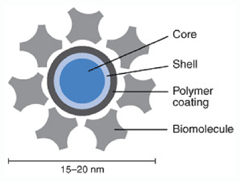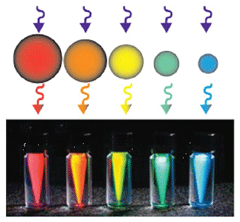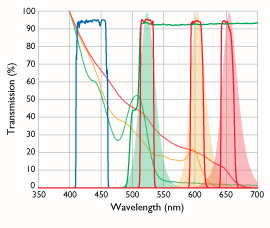
Semrock Optical Filters

Quantum dot nanocrystals are fluorophores in that they absorb photons of light and then re-emit longer-wavelength photons nearly instantaneously, however, there are some important differences between quantum dots (Qdot® nanocrystals made by Invitrogen Molecular Probes®) and traditional fluorophores. Quantum dots are nanometer-scale clusters of semiconductor atoms, typically coated with an additional semiconductor shell and then a polymer coating to enable coupling to proteins, oligonucleotides, small molecules, etc., which are then used for direct binding of the quantum dots to targets of interest.
Nanocrystals are extremely bright and highly photostable, allowing them to be archivable for permanent sample storage for pathology applications. These Qdots are also ideal for applications requiring high sensitivity and minimum label interference, such as live-cell imaging and dynamic studies. Due to the direct relationship between the size of the nanocrystal and the wavelength emitted, a full range of nanocrystals can be made – each with its own distinct emission spectrum and all excited by the same blue or UV wavelength, making nanocrystals a great choice for dense multiplexing.
To take full advantage of nanocrystal features, it is important to use properly optimized filters. Semrock offers BrightLine® QDot filter sets perfectly optimized for the most popular quantum dot imaging applications. A universal deep-blue exciter provides superior excitation efficiency while avoiding the excitation of DAPI and undesirable autofluorescence and preventing unnecessary phototoxic irradiation of the sample. This filter is combined with a dichroic beamsplitter with extremely wide reflection and transmission bands for maximum flexibility, and narrow, highly transmitting emission filters matched to each of the most important Qdot wavelengths.

Figure 1. Structure of a nanocrystal.

Figure 2. Nanocrystal size is directly related to emission wavelength.

Figure 3. A universal exciter is combined with a dichroic beamsplitter with ultra-wide reflection and transmission bands. The narrow-passband emission filters are optimized for the most common Qdot nanocrystal wavelengths.